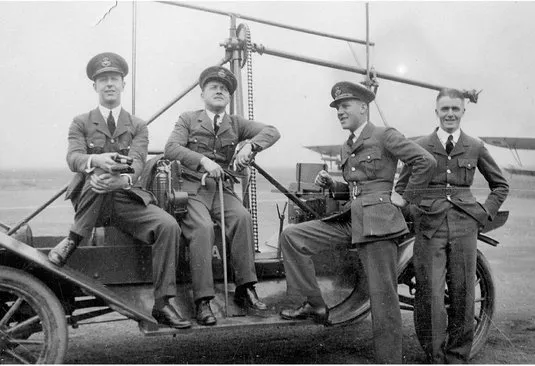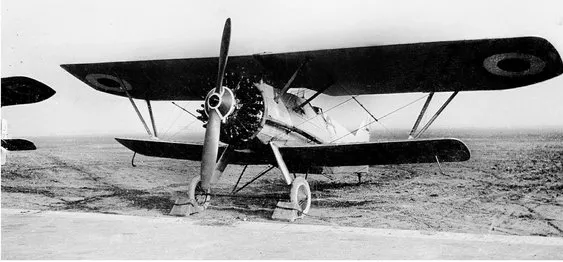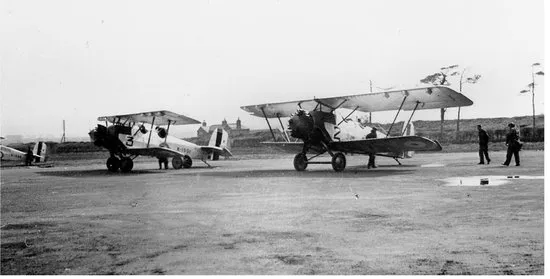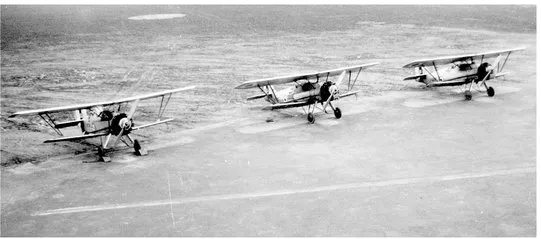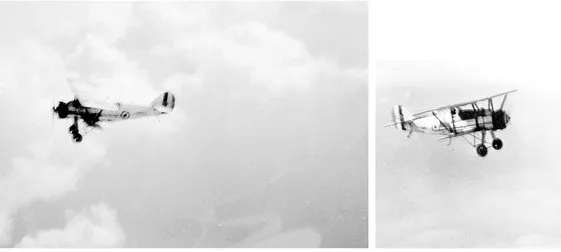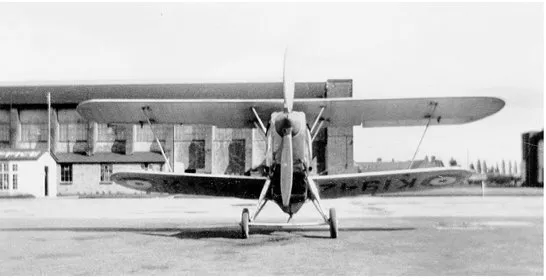![]()
CHAPTER ONE
FIGHTER PILOT AND TEST PILOT
Harvey Heyworth arrived at No 5 Flying Training School, RAF Sealand, fresh from his month of ‘square bashing’ at RAF Uxbridge in Middlesex, which was then the venue for courses for those who had been accepted for a Short Service Commission. (The RAF Short Service Commission scheme had been implemented in January 1924, with an Air Ministry announcement that 400 officers would be required for flying duties). On 30 September Harvey went aloft in Avro 504N J9686, spending forty minutes under the instruction of Flying Officer J.A. Simpson, who initiated him into the mysteries of taxiing and handling, the effect of controls with and without engine, and straight and level flying. Exactly one month later, with fifteen hours and twenty minutes of flying time under his belt, he was checked out by a Flight Lieutenant Yonge and sent off on his first ten minute solo flight.
On 1 January 1932, with his flying training well advanced under the tutelage of Flying Officer Simpson, Heyworth got his first taste of a more powerful military aircraft when Simpson took him for a 25-minute flight in Armstrong Whitworth Atlas J9472. The Atlas, which had been on the strength of No 5 FTS for about a year, came to grief only two days after Heyworth’s trip, when it was hit by Avro 504N J8501 as the latter was landing, and written off.
Harvey Heyworth’s initiation into flying with the RAF, like hundreds of other young pilots of the time, was in an Avro 504 trainer of the type seen here. This aircraft, J9428, was used by No 5 FTS at Sealand in 1930-31, but was not flown by Heyworth, the aircraft having left for another flying school at RAF Leuchars, Scotland, by the time he arrived. Author
RAF Sealand, 1931. Harvey Heyworth, left, perched on a Hucks Starter with three fellow pilot officers; ‘Peek’ Atkinson, ‘Wave’ Cameron and Alan Saw. Corinne Moore
On 29 February 1932, Harvey Heyworth completed his basic flying training on the Avro 504 with an assessment of ‘Above the Average’ and went on to begin his advanced training on the Armstrong Whitworth Siskin TM, the dual-control version of the biplane fighter. His instructor on the new type was an NCO, Sergeant Roxburgh, who sent Heyworth off solo on 13 April 1932. Heyworth’s log book reveals that he spent about a week practising pinpoint landings, with which he seems to have experienced some difficulty, as he was taken up by a Flight Lieutenant May in an Avro 504 on 18 April for further instruction. After that he got it right, and began a course of aerobatics.
Harvey Heyworth’s first taste of a more powerful biplane came on 1 January 1932, when he had a flight in an Armstrong Whitworth Atlas army co-operation aircraft. Corinne Moore
Above & below: Armstrong Whitworth Siskin IIIAs of No 5 FTS, RAF Sealand, on the flight line in 1931. Corinne Moore
His very thorough training continued in both the two-seat and single-seat Siskin variants, briefly reverting to the Avro 504 for demonstrations of compass errors and elementary instruction in blind flying, and by June 1932 he had amassed 100 flying hours, of which 64 were solo. At the end of August 1932 his total flying time had risen to 148 hours. He had now completed his flying training, again with an ‘Above the Average’ assessment, and was awarded his ‘wings’ on 4 September.
On 5 September 1932 Pilot Officer Harvey Heyworth was posted to No 54 (F) Squadron at Hornchurch in Essex, a station very much in the front line of Britain’s air defences. Having disbanded after the end of the 1914-18 war, No 54 Squadron had re-formed in 1930 and, after a few months operating Siskins, was now equipped with the Bristol Bulldog IIA, the last word in fighter biplanes. Heyworth settled happily into squadron life as a member of Flight Lieutenant Chapman’s ‘C’ Flight, flying at least once a day whenever the weather permitted, or more usually twice or even three times, carrying out a great deal of formation practice, cross-country flying, battle climbs and so on. Interestingly enough, his log book shows that it was only on 28 February 1933, after he had completed a total of 200 hours in the air, that he made his first night flight, which involved two circuits and two landings at Hornchurch. Night flying became more frequent after that, although not routine, and was accompanied by radiotelephony (R/T) practice. R/T equipment was progressively being fitted to all RAF fighter aircraft assigned to the air defence of Great Britain, and high priority was given to developing operational tactics with its aid.
Left & right: Taken by Harvey Heyworth from the cockpit of his own aircraft, these photographs show a Siskin IIIA flown by Pilot Officer John Grandy - later Marshal of the Royal Air Force Sir John Grandy, who became Chief of the Air Staff and who died in 2004 at the age of 90. Corinne Moore
On 30 June 1934 Heyworth formed part of the 54 Squadron aerobatic display team that performed at that year’s Hendon Air Pageant, an honour that reflected on his flying skill. Indeed, he continued to maintain his ‘Above the Average’ rating in all his flying assessments.
On 22 November 1934, Flying Officer Heyworth was posted to No 504 (County of Nottingham) Squadron, a Special Reserve squadron which had formed at Hucknall near Nottingham on 28 March 1928 as a day bomber unit equipped initially with Hawker Horsley light bombers. It had begun to rearm with the Westland Wallace in February 1934, and it was this type that Heyworth, who formed part of the squadron’s cadre of regular officers as Officer Commanding ‘B’ Flight, now flew, no doubt considering it rather a fall from grace after the nimble Bulldog. The task was far different too, involving such disciplines as air-to-ground photography, target towing and lots of cross country flying. In March 1935 Heyworth flew a Westland Wapiti, the type that was eventually to replace the Wallace.
This Hawker Fury visited Sealand in 1932. ‘The first Fury,’ Harvey Heyworth recorded, ‘what a thrill! Dick Morris was the pilot.’ Corinne Moore
Another visitor to Sealand, photographed by Harvey Heyworth, was this Fairey Flycatcher, a popular if somewhat ugly naval fighter biplane. Corinne Moore
In April 1936 Harvey Heyworth, now a flight lieutenant, became qualified to instruct in instrument flying. Later in the year, he was assessed as ‘Exceptional’ in his flying proficiency, an accolade awarded to very few pilots. In September 1936, his log book shows a total of just over 1093 flying hours. His five-year Short Service Commission was at an end. During that time he had flown fourteen different types of aircraft, including brief one-off trips in types such as the Gloster Gauntlet and Hawker Demon; the majority of his flying to date had been in the Bulldog (417 hours 35 minutes) and the Wallace (424 hours 30 minutes).
Westland Wallace army co-operation aircraft in formation. Flight
Harvey Heyworth’s last flight with the RAF, at least for the time being, took place on 8 September 1936, when he flew to Wittering for a promotion examination that would bring him the rank of squadron leader in the RAF Reserve of Officers, to which he now transferred. Meanwhile, he had already taken steps to ensure a career in civil aviation, and within 24 hours of leaving 504 Squadron he took up a post with Rolls-Royce Ltd. With him he brought a glowing testimonial from the Officer Commanding No 504 Squadron:
This is to certify that Flight Lieutenant J.H. Heyworth has completed 1100 flying hours to date. An exceptionally keen and very capable pilot, who is particularly good in bad weather. Would make a good test pilot or flying instructor. Flying Assessment: Exceptional.
Rolls-Royce had moved into two hangars at Hucknall in December 1934 and the aerodrome had become the centre for its engine test-flying activities. Prior to that, Rolls-Royce had begun its own flight testing early in the 1930s at Tollerton aerodrome near Nottingham. The company’s first test pilot was Ronnie Harker, who had joined Rolls-Royce as an apprentice in 1925 and who had learned to fly at Tollerton, later joining No 504 Squadron to augment his income. His first flight as a company test pilot was in November 1934, piloting a Gloster Gnatsnapper, which was fitted with an evaporatively-cooled Kestrel engine installed with condensers slotted into the leading edge of the upper wing. This method of cooling, advantageous in theory by reducing total drag, proved unsatisfactory when test-flown, and was superseded by a conventionally-located radiator system, with glycol as the coolant.
Shortly afterwards, Captain R.T. Shepherd – another ‘Ronnie’ – was invited to take up the post of chief test pilot. Shepherd was a veteran of the Royal Flying Corps and the RAF, and on leaving the Service he worked for a while as chief flying instructor with Phillips and Powis (later to become Miles Aircraft). He then became chief flying instructor with the Nottingham Flying Club, from where he was seconded to do some test flying with Rolls-Royce. Shepherd, Ronnie Harker, Harvey Heyworth and two other pilots, Wilfred Sutcliffe and Jock Bonar, were to share the company’s test flying programme throughout the remainder of the 1930s.
These were exciting times for Rolls-Royce, which was now at the forefront of aero-engine development in Britain. It had not always been so. In the years immediately after World War I it had seemed that the Americans and French had established a commanding lead in the development of high-performance aero-engines. In 1920-23, racing variants of the Nieuport-Delage 29 fighter, fitted with a 320hp Hispano-Suiza engine, improved on the world absolute air speed record seven times, as well as capturing numerous trophies, while the 1923 Curtiss CR-3 biplanes, powered by 400hp Curtiss D.12 engines, achieved first and second places in the Schneider Trophy contest. These foreign successes spurred the leading British aero-engine manufacturers into re-examining their engine design philosophy, and a clear leader of the field soon emerged in the shape of the Napier Company, which had been fully committed to the manufacture of military vehicles during the early part of the war but which had initiated the design and development of its first aero-engine, the Napier Lion, in 1917.
This engine, which was progressively uprated from 450hp to 14300hp during its career, was not completed in time for use during the war, but for a period of ten years from 1919 it achieved an enviable success record throughout the world. It was used in quantity in many types of military and civil aircraft, including the record-braking Fairey III series, and was also selected to power the early British entries for the Schneider Trophy contest, the Supermarine-Napier S.4 and S.5 and the Gloster-Napier IV and VI. In 1927 two of the RAF High Speed Flight’s S.5s became the only competitors to complete the course at Venice; the winner (N220, flown by Flight Lieutenant S.N. Webster) also establishing a new world seaplane speed record over a 100km closed circuit of 283.66mph.
In 1932, to meet the demand for air-cooled engines, Napier produced the 395hp Rapier, the first successful twin-crankshaft multi-cylinder aero-engine. It formed the basis for further Napier development of this arrangement, which was known as the ‘H’ type.
The R...


